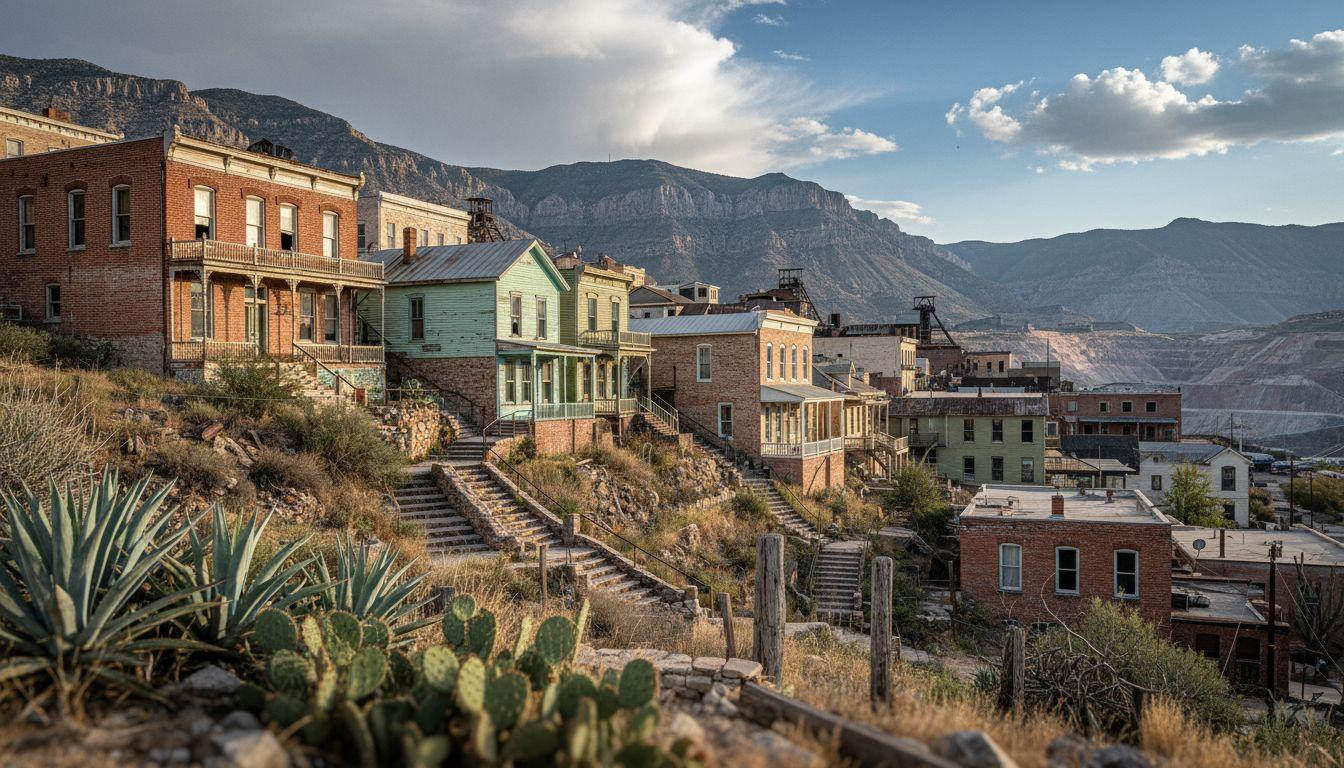Forget Tucson where Arizona-Sonora Desert Museum crowds pack around saguaro cacti for $25 admission and resort pools replace authentic desert culture. Drive 90 minutes southeast to discover Bisbee, a former copper mining town where Victorian buildings cling to impossible mountainside slopes and 5,000 residents have preserved what larger Arizona cities abandoned. This isn’t another Southwest tourist destination with chain hotels and manufactured experiences.
Here, at 5,538 feet elevation, the air stays 15-20 degrees cooler than Tucson’s desert floor. Morning light illuminates weathered brick facades from the 1890s while stairs carved into hillsides connect neighborhoods that exist nowhere else in Arizona.
Why Tucson lost its desert soul
Tucson’s 1.17 million metro residents live among shopping centers and chain restaurants that could exist anywhere in America. The city’s tourism machine processes visitors through predictable experiences. Resort pools substitute for desert exploration.
Summer temperatures routinely exceed 110°F, making outdoor activities miserable for half the year. Air conditioning becomes mandatory, not optional. The sprawling grid layout erases any sense of discovery or intimate scale.
Generic Southwest tourism dominates with cacti photo opportunities and manufactured “Old West” attractions. This Arizona lake town with London Bridge offers more authentic character than Tucson’s commercialized desert experience. Chain hotels and franchise restaurants have replaced local identity with predictable comfort.
Meet Bisbee’s vertical hillside identity
Bisbee defies Arizona stereotypes entirely. Victorian-era mining buildings climb steep mountainsides on crooked streets that follow natural contours rather than imposed grids. No two blocks look alike.
The town’s famous 1,000-stair climb race celebrates what other places would try to fix. Nine separate staircases totaling over 1,000 vertical steps connect different elevation levels across 4.5 miles of challenging terrain. Participants embrace the difficulty rather than avoid it.
Landscape that filters crowds
Steep streets discourage passive tourists who expect easy parking and level sidewalks. The topography naturally selects visitors willing to walk, climb, and explore. Cruise ship crowds can’t efficiently process through Bisbee’s vertical maze.
The Mule Mountains create natural barriers that preserved small-town character. Only 100,000 annual visitors find their way here compared to millions who overwhelm Sedona and Tucson attractions.
Arts revival from near-ghost status
When copper mining ended in 1975, Bisbee faced extinction. Instead, artists discovered affordable housing in abandoned mining infrastructure. The creative community that emerged stayed authentic because survival, not tourism, motivated the transformation.
“Keep Bisbee Weird” reflects genuine local identity rather than marketing strategy. Jerome’s 1890s mining hotels offer a similar but smaller-scale arts colony experience 200 miles north.
The hillside experience
Morning walks through empty staircases reveal hidden murals and overlooks impossible to find by car. The Queen Mine Tour descends into actual copper extraction tunnels where miners worked for nearly 100 years. This isn’t simulated heritage but preserved industrial reality.
Gallery hopping happens in historic storefronts along crooked streets. Working artists occupy studios in former mining buildings rather than tourist-oriented galleries. The Bisbee Mining and Historical Museum holds Smithsonian Institution affiliation, the first rural museum to achieve this recognition.
Activities built from history
Brewery Gulch preserves authentic saloon culture with St. Elmo’s Bar and Room 4 Bar, Arizona’s smallest bar. These aren’t theme park recreations but continuing establishments that serve locals and visitors equally.
The Lavender Pit overlook provides dramatic views of the massive open-pit mine that shaped the entire region. Colorado’s highest town shares similar Victorian mining architecture but at even higher elevation with winter sports.
Culture that stayed alive
Jimmy’s Hot Dog Company earned five-star recognition in Gourmet Magazine for exceptional quality, not tourist novelty. The Bisbee Breakfast Club serves locals first, visitors second. Authentic dining emerges from community need rather than visitor expectations.
Local events like the Bisbee 1,000 stair climb race create genuine community traditions. Nevada’s winter road closure demonstrates similar community adaptation to challenging terrain.
Practical planning
November through April offers ideal weather with daytime temperatures in the 60-80°F range and clear skies. Summer heat makes outdoor exploration uncomfortable, just like Tucson but at more manageable levels due to elevation.
Historic bed and breakfasts cost $100-200 per night, reflecting authentic character and limited inventory. No chain hotels exist to dilute the experience with predictable amenities. Advance booking for Queen Mine Tours is essential during peak season as tours operate every 1.5 hours from 9am to 3:30pm daily.
Your questions about Bisbee answered
How does Bisbee’s cost compare to Tucson resorts?
Bisbee’s historic accommodations cost $100-200 nightly while offering authentic character that Tucson’s chain hotels cannot replicate. Meals at local establishments like Jimmy’s range from $8-15, significantly less than resort dining. The experience value far exceeds the price difference.
Why did artists choose Bisbee over other mining towns?
When mining ended in 1975, housing became extremely affordable while Victorian architecture remained intact. The town’s isolation protected it from development pressure. Artists found both inspiration and survival possible in ways that weren’t available in more accessible locations.
What makes Bisbee different from Sedona or Jerome?
Bisbee maintains a working community of 5,000 residents rather than existing primarily for tourism. The arts scene emerged from necessity, not marketing. Prices remain reasonable because local economics, not visitor dollars, drive the basic cost structure.
Steam rises from morning coffee cups on Victorian porches as distant mountains catch first light. Weathered stairs climb toward galleries where artists work in former mining offices. This is Arizona without the crowds, heat, or commercialization that defines larger desert cities.
